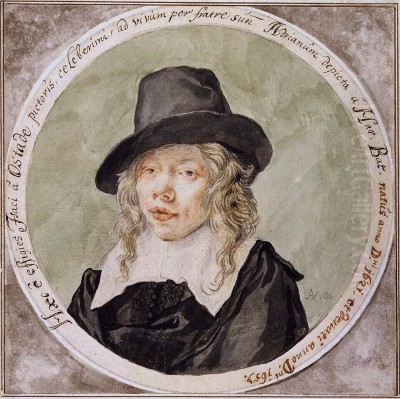
The Dutch Golden Age, spanning roughly the 17th century, was a period of extraordinary artistic flourishing in the Netherlands. Amidst a constellation of brilliant painters, Isaac van Ostade carved out a distinct and enduring niche for himself, despite a tragically short life. Born into an artistic family in Haarlem, he became a master of landscape and genre painting, capturing the rustic charm and atmospheric nuances of Dutch rural life with remarkable sensitivity and skill. Though his career lasted barely a decade, his evocative winter scenes and lively depictions of everyday folk continue to captivate audiences, securing his place as a significant figure in Western art history.
Early Life and Artistic Formation
Isaac van Ostade was baptized in Haarlem on June 2, 1621. He was the younger brother of Adriaen van Ostade, who was already establishing himself as a prominent painter of peasant life. It was under Adriaen's tutelage, in the bustling artistic hub of Haarlem, that Isaac received his initial training. The Haarlem school of painting was renowned for its realism and its focus on subjects drawn from contemporary life, providing a fertile ground for Isaac's developing talents.
While Adriaen was his primary teacher, the artistic environment of Haarlem exposed Isaac to various influences. Some early accounts suggest both brothers may have spent time in the studio of the great portraitist Frans Hals, perhaps alongside the Flemish émigré Adriaen Brouwer. While the direct stylistic impact of Hals on the Ostade brothers seems limited, the raw energy and keen observation found in Brouwer's peasant scenes certainly resonated with both, particularly influencing their thematic choices and, at times, their vigorous brushwork. However, Isaac would soon forge his own path, distinct from both his brother and these potential early influences.
Emergence of a Unique Style
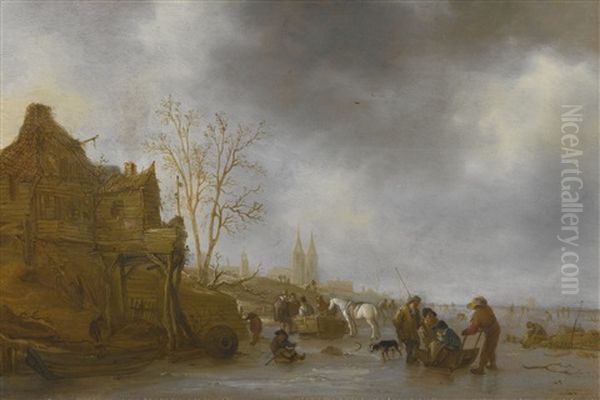
Isaac's earliest works, dating from the very late 1630s or early 1640s, understandably show the strong influence of his brother Adriaen. These paintings often depict dimly lit interiors, focusing on peasant gatherings, sometimes with a slightly caricatured or coarse quality reminiscent of Adriaen's earlier style. There are also suggestions, noted in some analyses, of an early awareness of Rembrandt's dramatic use of light and shadow, though this influence appears less defining than that of his brother or Brouwer.
However, by around 1643, the year he joined the Haarlem Guild of Saint Luke as an independent master, Isaac began to assert his artistic individuality. A pivotal shift occurred in his work: he moved increasingly away from dark interiors towards brighter, more open-air scenes. His canvases became lighter in tone, his palette brightened, and his focus shifted decisively towards landscapes, often populated with figures engaged in everyday activities. This transition marked the beginning of his mature style, characterized by a remarkable ability to integrate genre elements seamlessly within atmospheric landscape settings.
Mastery of Light and Atmosphere
A defining characteristic of Isaac van Ostade's mature work is his exceptional handling of light and atmosphere. He moved away from the stark chiaroscuro sometimes seen in his earliest pieces towards a more nuanced and naturalistic depiction of daylight. His outdoor scenes are bathed in a cool, often silvery light that perfectly captures the specific conditions of the Dutch climate, whether it be the crisp air of a winter's day or the softer light of summer.
He masterfully used light not just for illumination but also to create mood and unify his compositions. Sunlight might filter through trees, glint off frozen canals, or highlight figures emerging from the shadow of an inn, adding vibrancy and depth to the scene. His skies are rarely mere backdrops; they are active components of the painting, with carefully observed cloud formations contributing to the overall atmospheric effect. This sensitivity to natural light distinguishes his work and lends it a palpable sense of place and time.
A Distinctive Color Palette
Complementing his use of light, Isaac developed a distinctive color palette that contributed significantly to the character of his paintings. While his early works sometimes employed darker, earthier tones similar to Adriaen's, his mature style embraced cooler and more varied colors. Silvery greys, cool blues, pale yellows, and subtle greens dominate his landscapes, particularly his renowned winter scenes.
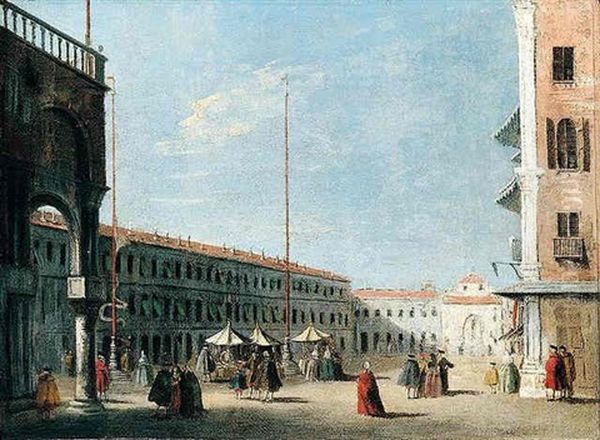
He used color thoughtfully to enhance the sense of realism and atmosphere. The muted tones of winter landscapes effectively convey the chill in the air, while warmer accents – a red waistcoat, the brown of a horse, the ochre of a building – provide focal points and add visual interest without disrupting the overall harmony. His application of paint was often fluid and assured, allowing him to capture textures and reflections with convincing realism. The interplay of these carefully chosen colors contributes significantly to the gentle, often tranquil mood of his best works.
Key Themes: Winter Landscapes
Isaac van Ostade is perhaps most celebrated for his winter landscapes, a theme he made distinctively his own. These paintings capture the Netherlands transformed by ice and snow, becoming stages for communal activity and quiet beauty. Frozen canals and rivers teem with life: figures skate with varying degrees of elegance, children push sleds, men play games like "kolf" on the ice, and horse-drawn sleighs glide across the frozen expanse.
These scenes are rendered with an exquisite sensitivity to the specific light and atmosphere of winter. Bare trees etch delicate patterns against pale skies, snow blankets rooftops and fields, and the low winter sun casts long, cool shadows. Works like Winter Landscape (numerous versions exist) exemplify his ability to combine detailed observation of human activity with a broader, atmospheric depiction of the landscape. He captures not just the appearance of winter, but the feeling of it – the crisp air, the muffled sounds, the communal spirit fostered by the cold.
Key Themes: Inn Scenes and Travellers
Another signature theme for Isaac is the scene outside a country inn. These paintings often depict travellers halting their journey, perhaps arriving in a coach or on horseback, pausing for refreshment and rest. The inn itself, typically a rustic building, serves as a focal point around which various activities unfold: horses are unharnessed or watered, figures converse, children play, and dogs forage for scraps.
These compositions allowed Isaac to explore the interplay between figures, animals, and architecture within a landscape setting. Paintings titled Travellers Halting at an Inn or A Village Scene with a Coach showcase his skill in arranging complex groups of figures in a naturalistic way. These works reflect the importance of travel and roadside hospitality in 17th-century Dutch life, rendered with his characteristic blend of keen observation, gentle light, and atmospheric sensitivity. They offer charming glimpses into the everyday comings and goings of rural society.
Key Themes: Rural Life and the Peasantry
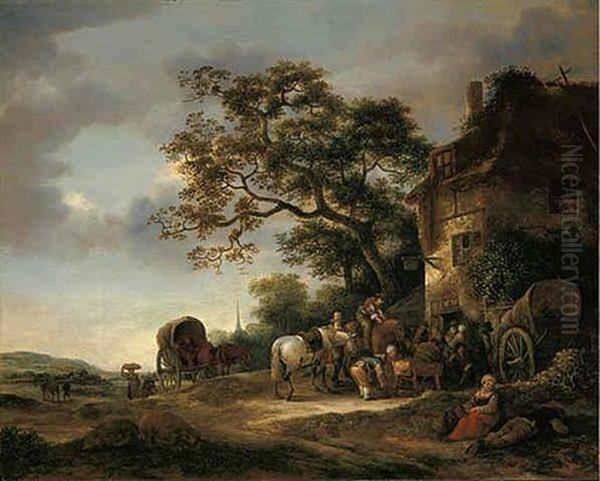
While his brother Adriaen became increasingly known for interior peasant scenes, Isaac often depicted rural folk in outdoor settings, engaged in their daily labours or moments of leisure. He painted village fairs, markets, and scenes of agricultural life, such as the iconic The Pig Slaughter. His portrayal of the peasantry is generally realistic and sympathetic, avoiding the overt moralizing or caricature found in the work of some contemporaries like Jan Steen, though a gentle humour is often present.
Isaac observed the details of rural existence closely – the textures of clothing, the tools of labour, the postures of figures at work or rest. He integrated these figures naturally into their landscape environment, emphasizing their connection to the land and the seasons. Unlike the sometimes boisterous or chaotic scenes of Adriaen Brouwer, Isaac's depictions of peasant life tend to be calmer and more harmoniously composed, reflecting his greater interest in landscape and atmosphere.
The Relationship with Adriaen van Ostade
The artistic relationship between Isaac and his older brother Adriaen was fundamental to Isaac's career, evolving from mentorship to parallel practice. Initially, Isaac was clearly the pupil, absorbing Adriaen's techniques and thematic interests. However, as Isaac developed his own focus on landscape and brighter, outdoor scenes, their paths diverged stylistically, although they remained personally and professionally connected within the Haarlem art community.
Confusion between their works, particularly Isaac's earlier pieces and Adriaen's output, has occurred historically, though their mature styles are generally distinguishable. A poignant testament to their bond is the fact that Adriaen is known to have completed some of Isaac's unfinished paintings after his younger brother's untimely death. Furthermore, anecdotes survive suggesting their close ties, including one instance where Adriaen reportedly sued a dealer on Isaac's behalf when one of the younger brother's paintings was sold for a disappointingly low price, highlighting the economic precariousness artists could face even amidst the Golden Age boom.
The Haarlem Context and Contemporaries
Isaac van Ostade's entire brief career unfolded within the vibrant artistic milieu of Haarlem. His membership in the Guild of Saint Luke from 1643 placed him formally within this community. Haarlem in the mid-17th century was a powerhouse of painting, particularly strong in landscape and genre. Isaac worked alongside, and was aware of, numerous talented contemporaries who contributed to the city's artistic reputation.
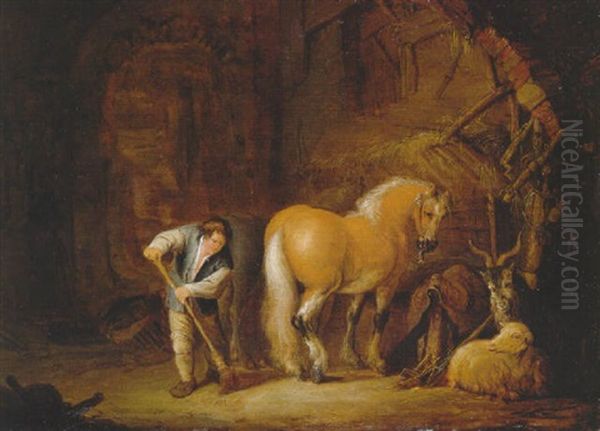
These included the towering figure of Frans Hals, landscape specialists like Salomon van Ruysdael and his more famous nephew Jacob van Ruisdael (though Jacob's main output came slightly later), the painter of elegant equestrian scenes Philips Wouwerman, and Nicolaes Berchem, known for his Italianate landscapes but also active in Haarlem. The influence of artists from other Dutch cities, such as the tonal landscape painter Jan van Goyen (The Hague/Leiden) or the great Rembrandt (Amsterdam), also permeated the artistic discourse. Isaac's specific blend of landscape and genre found a ready market in a society increasingly interested in depictions of its own land and people. He also reportedly collaborated on occasion, for instance, with the landscape painter Jacob van Mosscher.
Representative Works Explored
Several paintings stand out as representative of Isaac van Ostade's achievement. His numerous Winter Landscape variations showcase his mastery of atmospheric effects and his ability to orchestrate complex scenes of figures enjoying the ice. The compositions are typically expansive, drawing the viewer's eye into the distance across the frozen waterways, under vast, subtly rendered skies. The delicate balance between the detailed rendering of individual figures and the overall sense of place is remarkable.
Travellers Halting at an Inn (examples in the National Gallery, London, and the Rijksmuseum, Amsterdam) epitomizes his other major theme. These works demonstrate his skill in composing intricate groups of people, horses, and carriages within a convincingly rustic setting. The play of light on the inn's facade, the naturalistic poses of the figures, and the integration of the scene into a wider landscape context are characteristic strengths. A work sometimes titled Village Street Scene or similar, perhaps depicting craftsmen or villagers outside buildings, would also fit within this popular category, highlighting his focus on the social fabric of rural life. The Pig Slaughter (e.g., Museum Boijmans Van Beuningen, Rotterdam) shows his ability to tackle less idyllic aspects of country life with realism and compositional skill. Even themes like The Fiddler, common in Dutch genre painting, appear in his oeuvre, likely depicted outdoors contributing to a village scene.
Influence and Legacy
Despite dying at the young age of 28, Isaac van Ostade left a significant legacy. His innovative integration of genre figures into atmospheric landscapes, particularly his winter scenes, proved highly influential. His approach offered a compelling alternative to both the pure landscapes of painters like Van Goyen and the primarily figure-focused interiors of artists like his brother Adriaen or Jan Steen.
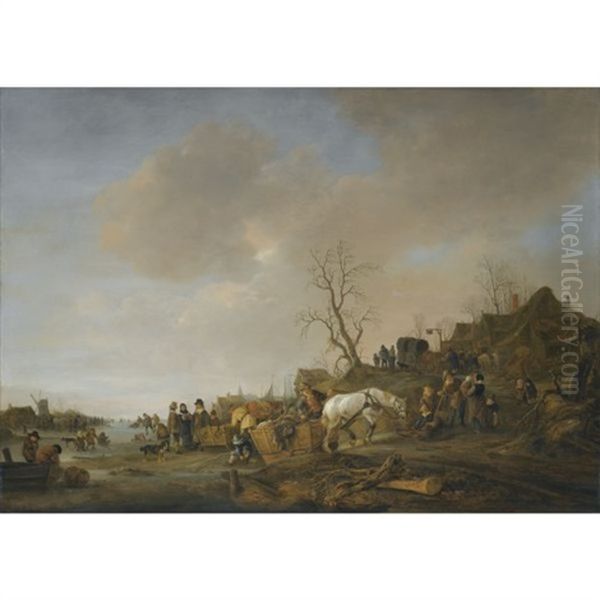
Later Dutch artists, including Claes Molenaer (mentioned in the source material as influenced by him) and potentially early works by figures associated with genre and landscape, absorbed aspects of his style. His paintings were highly sought after by collectors, especially in the 18th and 19th centuries in England and France, who admired their picturesque charm and technical finesse. His work continues to be prized for its evocative portrayal of 17th-century Dutch life and landscape. His ability to capture specific moments and moods with such clarity and sensitivity ensures his enduring appeal.
Conclusion: A Brief Brilliance
Isaac van Ostade's career was a brief but brilliant flash within the Dutch Golden Age. In just a decade of independent work, he moved from being a promising pupil of his accomplished brother to becoming a distinct and innovative master in his own right. His specialization in atmospheric landscapes, particularly winter scenes and views outside country inns, filled with lively and naturalistically observed figures, marked a significant contribution to Dutch art. He captured the essence of the Dutch countryside and the everyday lives of its inhabitants with a unique blend of realism, sensitivity to light, and compositional harmony. While his early death in Haarlem on October 16, 1649, undoubtedly cut short a career of immense potential, the works he did leave behind solidify his reputation as a true luminary of his time, whose charming and evocative paintings remain a testament to his exceptional talent.